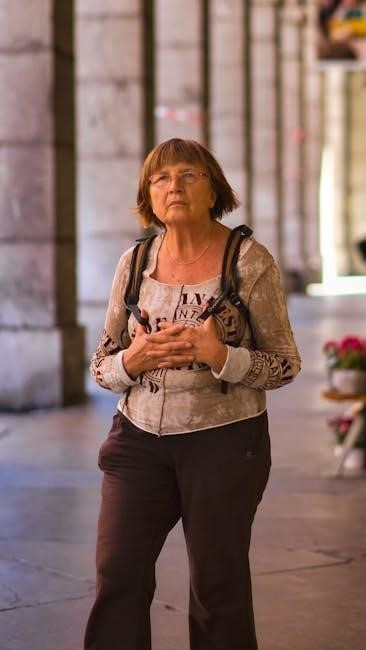Embark on a spine-chilling journey through London’s East End, exploring the infamous sites linked to Jack the Ripper’s crimes․ This self-guided tour offers a unique opportunity to delve into the history of the Whitechapel Murders at your own pace, using audio guides or detailed maps to navigate the key locations․ Discover the dark past of Victorian London and uncover the mysteries surrounding one of history’s most notorious serial killers․
Overview of the Tour
This self-guided walking tour takes you through the historic streets of London’s East End, focusing on the infamous Jack the Ripper murders․ Starting at Aldgate East, the tour covers approximately 8 key locations, including Whitechapel Road, Hanbury Street, and Mitre Square․ Designed for flexibility, the tour allows you to explore at your own pace, using audio guides or detailed maps to navigate․ Each stop provides insights into the crimes, the victims, and the social conditions of Victorian London․ The tour is perfect for true crime enthusiasts and history buffs, offering a unique blend of storytelling and immersive exploration․ With GPS-based navigation and engaging narratives, you’ll uncover the chilling history behind one of London’s most notorious serial killers․
Importance of Exploring Jack the Ripper’s History
Exploring Jack the Ripper’s history through a self-guided walking tour offers a unique opportunity to understand the social and cultural context of Victorian London․ The tour sheds light on the harsh living conditions of the East End, particularly for women, and highlights the societal issues that contributed to the crimes․ By examining the victims’ stories and the impact of the murders, participants gain insight into how these events shaped public perception and criminal investigations․ This tour not only delves into the crimes but also honors the victims, providing a deeper understanding of this dark chapter in history and its lasting legacy on true crime storytelling․

Historical Context of Jack the Ripper
The Jack the Ripper murders occurred during the Victorian era, a time of significant social inequality and poverty in London’s East End, fueling the crimes’ notoriety․
The Victorian Era and Social Conditions
The Victorian Era, spanning from 1837 to 1901, was marked by stark social inequalities and overcrowding in London’s East End․ Poverty, poor sanitation, and limited opportunities fueled desperation among the working class, particularly women, many of whom turned to prostitution to survive․ The cramped, unsanitary living conditions in Whitechapel created a breeding ground for crime and exploitation․ The Jack the Ripper murders highlighted these dire social issues, drawing attention to the plight of the East End’s most vulnerable residents․ The era’s rigid class system and lack of social reforms exacerbated these problems, making the area a hotspot for violence and despair․
The Whitechapel Murders
The Whitechapel Murders, a series of brutal and unsolved killings, shocked Victorian London in 1888․ The crimes, attributed to Jack the Ripper, targeted vulnerable women, many engaged in prostitution․ The killings were marked by extreme violence, with victims found mutilated beyond recognition․ Despite extensive investigations, the killer’s identity remained a mystery, fueling speculation and public fear․ These murders not only horrified the nation but also exposed the harsh realities of poverty and exploitation in the East End․ The walking tour revisits the sites of these tragic events, offering a somber reflection on the lives lost and the social conditions that allowed such atrocities to occur․
The Investigation and Legacy
The investigation into the Whitechapel Murders was one of the most extensive of its time, yet Jack the Ripper was never caught․ Police faced numerous challenges, including limited forensic techniques and a lack of eyewitnesses․ The case sparked widespread panic and criticism of law enforcement․ Despite their efforts, the killer’s identity remains unknown, fueling endless theories and speculation․ The murders left a lasting impact on London’s history, shaping public perception of serial killers and influencing crime reporting․ Today, the legacy of Jack the Ripper is a mix of fascination and horror, drawing tourists and enthusiasts to explore the sites and stories behind these infamous crimes․

Key Locations on the Walking Tour
Explore the eerie streets of Whitechapel and Spitalfields, visiting iconic sites like Aldgate East, Hanbury Street, and Mitre Square․ Each location reveals a chilling chapter in Jack the Ripper’s infamous crimes, offering a glimpse into the dark history of London’s East End․
Aldgate East: Starting Point
Aldgate East serves as the ideal starting point for your self-guided Jack the Ripper walking tour, immersing you in the eerie atmosphere of Victorian London․ This bustling area marks the gateway to the infamous streets where the Whitechapel Murders unfolded․ As you begin your journey, the modern-day vibrancy of the city gradually gives way to the haunting history of the East End․ The proximity to key crime scenes makes Aldgate East a logical starting point, allowing you to navigate effortlessly through the narrow alleys and historic landmarks․ Equipped with a map or audio guide, you’ll set the tone for an unforgettable exploration into the shadows of Jack the Ripper’s terrifying legacy․
Whitechapel Road: The Heart of the Murders
Whitechapel Road stands as a central location in the Jack the Ripper narrative, its bustling streets once a hub of activity during the late 19th century․ This vibrant area, filled with markets and shops, contrasts sharply with the dark history of the infamous murders․ As you walk along Whitechapel Road, you’ll delve into the heart of the events that shocked Victorian London․ The road’s historical significance lies in its proximity to several crime scenes, making it a pivotal stop on the tour․ The area’s atmosphere reflects the social and economic struggles of the time, offering a glimpse into the lives of those affected by the brutal killings․
Hanbury Street: A Grisly Discovery
Hanbury Street is a pivotal stop on the Jack the Ripper tour, marking the site where Annie Chapman, the second canonical victim, was brutally murdered in 1888․ This narrow, atmospheric street was once a bustling part of Whitechapel, filled with costermongers and locals․ The discovery of Chapman’s body sent shockwaves through the community, as it revealed the escalating violence of the killer․ A torn apron found near her body became a key clue, suggesting the killer may have fled in haste․ Today, visitors can stand on the same cobblestones where this tragic event occurred, imagining the chaos and fear that gripped the neighborhood․ The site remains a haunting reminder of the dark history embedded in these streets․

Buck’s Row: The First Victim
Buck’s Row, now renamed Durward Street, holds a somber place in history as the location of Jack the Ripper’s first canonical murder․ On August 31, 1888, Mary Ann Nichols was found brutally murdered here, her body left in a state that shocked even the hardened locals․ The street, once a dimly lit alleyway, was a hub of activity for the area’s poorer residents․ Nichols’ murder set the stage for the terrifying series of events that followed․ Visitors can reflect on the harsh conditions of the time and the tragic fate of Nichols, whose death marked the beginning of the Ripper’s reign of terror․ The site serves as a poignant reminder of the era’s social struggles and the victims’ untimely demise․
Mitre Square: A Chilling Site
Mitre Square, a quiet, cobblestone-paved courtyard, is one of the most haunting stops on the Jack the Ripper walking tour․ It was here, on September 30, 1888, that Catherine Eddowes became the fourth canonical victim of the infamous killer․ Her mutilated body was discovered in the early hours of the morning, shocking even the seasoned police officers who found her․ The square’s eerie atmosphere and historical significance make it a poignant reminder of the terror that gripped London during the Ripper’s spree․ Visitors can reflect on the tragic events that unfolded here, which remain etched in the city’s dark history․ The site serves as a chilling testament to the brutality of the era․
Goulston Street: The Enigmatic Graffiti

Goulston Street holds a unique place in the Jack the Ripper saga due to the infamous graffiti discovered there․ On September 30, 1888, after Catherine Eddowes’ murder, a cryptic message was found on a wall near her apron, which read, “The Juwes are the men that will not be blamed for nothing․” This enigmatic scribble has sparked endless debate among historians and Ripper enthusiasts․ Some believe it was written by the killer himself, while others argue it was a red herring․ The phrase’s potential anti-Semitic undertones and its mysterious origins continue to intrigue, adding another layer of complexity to the case․ This site remains a focal point for speculation and theorizing about Jack the Ripper’s identity and motives․
Spitalfields Market: Contrasting Vibes
Spitalfields Market offers a stark contrast to the grim history of Jack the Ripper’s crimes, blending Victorian charm with modern vibrancy․ Today, the market is a bustling hub of culture, food, and shopping, attracting locals and tourists alike․ Its historic architecture, including the iconic clock tower, stands as a testament to the area’s rich past․ While the market’s lively atmosphere differs sharply from the dark events of the late 19th century, it provides a unique opportunity to reflect on how the neighborhood has evolved․ Visitors can explore the stalls, enjoy diverse cuisine, and experience the dynamic energy of this historic East End landmark, creating a fascinating juxtaposition of past and present․
Christ Church, Spitalfields: Historical Landmark
Christ Church, Spitalfields, stands as a majestic landmark near the heart of the Jack the Ripper walking tour․ Built in the early 18th century, this stunning example of Georgian architecture offers a serene contrast to the area’s dark history․ The church’s towering spire and grand design make it a striking feature of the East End skyline․ Visitors can step inside to admire its intricate interiors and reflect on its role as a spiritual anchor for the community during the tumultuous Victorian era․ Today, it remains a vital part of the neighborhood’s heritage, blending history, faith, and culture seamlessly․

The Victims of Jack the Ripper
The tragic stories of Jack the Ripper’s victims, including Mary Ann Nichols, Annie Chapman, and others, highlight the harsh realities faced by women in Victorian London’s East End․
Mary Ann Nichols: The Canonical Series
Mary Ann Nichols, the first canonical victim of Jack the Ripper, was found brutally murdered on August 31, 1888, in Buck’s Row, Whitechapel․ Her death marked the beginning of a terrifying series of killings that shocked Victorian London․ Nichols, a impoverished prostitute, was discovered with severe throat injuries and abdominal mutilations, setting a gruesome precedent for the Ripper’s later crimes․ The investigation into her murder, led by Inspector Charles Moore, remains one of the most documented cases in the series․ Visitors on the self-guided tour can pay their respects at a memorial near the site where her body was found, reflecting on the tragic circumstances of her life and death․
Annie Chapman: Tragic End
Annie Chapman, the second canonical victim of Jack the Ripper, was found murdered on September 8, 1888, in the backyard of 29 Hanbury Street, Whitechapel․ Her body was discovered with severe injuries, including a slit throat and extensive abdominal mutilations․ Chapman, like Nichols, was a vulnerable prostitute struggling with poverty and addiction․ The Ripper’s brutality escalated with her murder, as organ removals were noted, fueling speculation about the killer’s motives․ The self-guided tour stops at Hanbury Street, where a somber plaque commemorates her tragic fate, offering a moment for reflection on her life and the societal conditions that led to her untimely death․
Liz Stride: Mysterious Circumstances
Liz Stride, the third canonical victim of Jack the Ripper, was found brutally murdered on September 30, 1888, in a courtyard off Berner Street, Whitechapel․ Her body bore the hallmark of a slit throat, but unlike previous victims, there were no extensive abdominal mutilations, leading to speculation that the killer was interrupted․ Stride’s life was marked by hardship, including the loss of her husband and children, which drove her to prostitution․ The self-guided tour visits the site of her murder, where visitors can reflect on her tragic fate and the eerie circumstances surrounding her death․ This location remains a pivotal stop in understanding the Ripper’s elusive modus operandi․
Catherine Eddowes: A Theorized Connection
Catherine Eddowes, the fourth canonical victim of Jack the Ripper, was found murdered on September 30, 1888, in Mitre Square․ Her case is notable for the discovery of a piece of torn apron near her body, which some theories suggest was used to carry organs removed from her body․ The “Goulston Street Graffiti,” found nearby, sparked debates about its connection to the killer and Eddowes․ Her life, marked by poverty and occasional imprisonment, reflects the harsh realities of Victorian London’s underclass․ The self-guided tour visits Mitre Square, where visitors can contemplate the mystery surrounding her death and the enduring theories linking her to the broader narrative of the Whitechapel Murders․
Mary Jane Kelly: The Most Brutal Murder
Mary Jane Kelly, the fifth canonical victim of Jack the Ripper, met her tragic end on November 9, 1888, in her room at 13 Miller’s Court․ Her murder is considered the most brutal of the series due to the extensive mutilations inflicted․ Kelly, a young Irish prostitute, was found with organs removed and ritualistic injuries, fueling theories about the killer’s motivations․ The crime scene photos, widely circulated, shocked the public and intensified the investigation․ This self-guided tour stops near Miller’s Court, allowing visitors to reflect on Kelly’s life and the horrifying circumstances of her death, which remain a pivotal and disturbing chapter in the Jack the Ripper saga․

Self-Guided Tour Resources
Enhance your experience with audio guides, downloadable maps, and books detailing the murders․ These resources provide navigation and insights, ensuring a comprehensive understanding of the Jack the Ripper legacy․
Using Audio Guides and Apps
Audio guides and apps are essential tools for navigating the Jack the Ripper self-guided walking tour․ These resources provide immersive storytelling, historical context, and GPS navigation to key murder sites․ Many apps, like Vox City, offer multilingual narratives, allowing visitors to explore at their own pace․ They feature chilling accounts of the victims and the social conditions of Victorian Whitechapel․ Some apps even enable users to start the tour from any location, ensuring flexibility․ Downloadable maps and audio files are also available, offering a seamless experience․ These tools not only enhance the tour but also provide a deeper understanding of the events, making the journey both educational and engaging․

Downloadable Maps and Routes
Downloadable maps and routes are indispensable for navigating the Jack the Ripper self-guided walking tour․ These resources provide a clear path through Whitechapel and Spitalfields, highlighting key locations linked to the murders․ Many maps are available online, offering detailed directions to sites like Aldgate East, Hanbury Street, and Mitre Square․ While some original buildings have been demolished, the maps guide visitors to the approximate areas where the crimes took place․ Combining these maps with audio guides or apps enhances the experience, ensuring a seamless journey through the historical sites․ They are perfect for those who prefer a self-paced, independent exploration of Jack the Ripper’s haunting legacy․
Relevant Books and Articles
Enhance your Jack the Ripper self-guided walking tour with insightful books and articles that delve into the history of the Whitechapel Murders․ Guides like Lindsay Siviter’s works offer detailed analyses of the crimes and their social context․ Books such as “Jack the Ripper: The Final Solution” provide theories and timelines, while articles from historical societies shed light on the victims’ lives․ Many free online resources, like the self-guided tour guide by Free Tours By Foot, include maps and narratives to enrich your experience․ These materials offer a deeper understanding of the era, the victims, and the killer, making your tour more engaging and informative․

Preparing for the Tour
Download maps and audio guides in advance, ensuring your device is fully charged․ Wear comfortable shoes and check the weather․ Familiarize yourself with the route to navigate smoothly․ Bring essentials like water and snacks․ Respect historical sites and follow local guidelines to ensure a meaningful experience․
Essentials to Bring Along
For a seamless experience, ensure you bring a fully charged smartphone for audio guides and navigation apps․ Carry a portable charger, water, and snacks․ Wear comfortable walking shoes suitable for London’s cobblestone streets․ Bring a lightweight rain jacket or umbrella, as weather can be unpredictable․ A small backpack or crossbody bag will help keep essentials handy․ Print or download a map of the route as a backup․ Dress in layers for changing temperatures and wear comfortable clothing․ Lastly, bring a notebook and pen if you wish to jot down key points or reflections during the tour․ Being prepared ensures you can focus on the history and atmosphere․
Understanding the Route and Navigation
Navigation is key to a smooth self-guided tour experience․ Begin at Aldgate East, a common starting point, and follow the mapped route through Whitechapel and Spitalfields․ Use GPS-enabled audio guides or apps to track your progress and receive real-time commentary․ Download maps in advance to avoid relying on internet access․ Familiarize yourself with the route beforehand to ensure a logical flow between sites․ Allow 1․5 to 2 hours for the tour, depending on your pace․ While the route is structured, feel free to explore adjacent areas or linger at sites of interest․ Clear signage and landmarks will help guide you, but staying attentive is crucial to staying on track․
Respecting Historical Sites
Respecting historical sites is paramount during the Jack the Ripper self-guided walking tour․ Many locations, such as churches and memorials, hold deep historical significance and may still be in use today․ Visitors are encouraged to behave respectfully, avoiding littering, loud noises, or disruptive behavior․ Refrain from touching or damaging any memorials, plaques, or buildings tied to the victims or events․ Be mindful of residential areas and businesses along the route, as they are part of the living community․ By maintaining a thoughtful and considerate attitude, you honor the victims and preserve these sites for future generations to explore and learn from․

Engaging with the Tour
Immerse yourself in the chilling history of Jack the Ripper using audio guides, interactive maps, and storytelling․ Engage deeply with the narrative, uncovering the dark legacy and its impact on London’s past․
Immersive Storytelling and Narration
The self-guided tour enhances your experience with vivid storytelling, bringing the Victorian era to life․ Audio narratives provide detailed accounts of each murder site, victim’s stories, and the social context․ Multilingual guides ensure accessibility for all visitors․ The immersive approach allows you to visualize the past, connecting emotionally with the events․ You’ll gain insights into the investigations and the lasting impact on London’s history․ The engaging format makes the tour both educational and captivating, leaving a lasting impression of Jack the Ripper’s infamous legacy․
Exploring Nearby Attractions
After delving into the dark history of Jack the Ripper, take time to explore the vibrant attractions near the tour route․ Spitalfields Market offers a lively contrast, with its eclectic shops, street food, and cultural vibe․ Christ Church, Spitalfields, stands as a striking historical landmark nearby, showcasing stunning Georgian architecture․ The Ten Bells Pub, a haunt of some of the victims, provides a glimpse into the era’s social life․ These nearby sites offer a refreshing break from the grim narrative, allowing visitors to experience the area’s modern charm and rich heritage․ They are within walking distance, making it easy to extend your day with diverse cultural experiences․
Sharing Your Experience
Sharing your experience of the Jack the Ripper Self-Guided Walking Tour is a great way to connect with others who are equally fascinated by history and mystery․ Take photos and videos of the key sites, such as the Ten Bells Pub or Spitalfields Market, and share them on social media using relevant hashtags like #JackTheRipper or #Whitechapel․ Write a review or blog post about your tour, highlighting what you found most intriguing․ Many platforms allow you to rate and comment on self-guided tours, helping others plan their own adventures․ You can also join online forums or groups dedicated to true crime history to discuss your insights and learn from others․ Sharing your journey not only preserves your memories but also contributes to the ongoing conversation about this infamous chapter in London’s history․
Reflecting on the Experience
Reflecting on the Jack the Ripper tour, participants often leave with a deeper appreciation of history’s mysteries and the enduring legacy of this infamous case․
Reflecting on the Jack the Ripper self-guided walking tour, participants often describe it as a haunting yet enlightening journey․ The tour provides a unique opportunity to connect with history, immersing oneself in the dark, atmospheric streets of London’s East End․ By exploring the key locations tied to the infamous murders, visitors gain a deeper understanding of the social and cultural context of Victorian-era London․ The experience also sparks reflection on the victims’ lives and the enduring mystery surrounding the killer’s identity․ Many find the tour to be both educational and emotionally impactful, leaving a lasting impression of the tragic events that shaped this chapter of history․
The Enduring Fascination with Jack the Ripper
The enduring fascination with Jack the Ripper stems from the unsolved nature of his crimes and the chilling mystery surrounding his identity․ Over a century later, the Victorian-era serial killer continues to captivate historians, true crime enthusiasts, and the general public․ The self-guided walking tour taps into this intrigue, offering a unique way to explore the historical sites tied to the murders․ By delving into the lives of the victims and the societal conditions of the time, participants gain a deeper understanding of why Jack the Ripper’s legacy remains so compelling․ The tour not only highlights the dark history but also sparks reflection on the human stories behind the infamous crimes․
